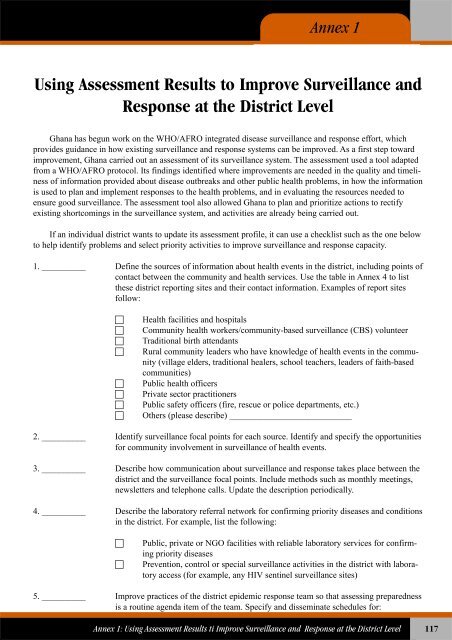Technical Guidelines for Integrated Disease Surveillance ... - PHRplus
Technical Guidelines for Integrated Disease Surveillance ... - PHRplus
Technical Guidelines for Integrated Disease Surveillance ... - PHRplus
Create successful ePaper yourself
Turn your PDF publications into a flip-book with our unique Google optimized e-Paper software.
Annex 1Using Assessment Results to Improve <strong>Surveillance</strong> andResponse at the District LevelGhana has begun work on the WHO/AFRO integrated disease surveillance and response ef<strong>for</strong>t, whichprovides guidance in how existing surveillance and response systems can be improved. As a first step towardimprovement, Ghana carried out an assessment of its surveillance system. The assessment used a tool adaptedfrom a WHO/AFRO protocol. Its findings identified where improvements are needed in the quality and timelinessof in<strong>for</strong>mation provided about disease outbreaks and other public health problems, in how the in<strong>for</strong>mationis used to plan and implement responses to the health problems, and in evaluating the resources needed toensure good surveillance. The assessment tool also allowed Ghana to plan and prioritize actions to rectifyexisting shortcomings in the surveillance system, and activities are already being carried out.If an individual district wants to update its assessment profile, it can use a checklist such as the one belowto help identify problems and select priority activities to improve surveillance and response capacity.1. __________ Define the sources of in<strong>for</strong>mation about health events in the district, including points ofcontact between the community and health services. Use the table in Annex 4 to listthese district reporting sites and their contact in<strong>for</strong>mation. Examples of report sitesfollow:Health facilities and hospitalsCommunity health workers/community-based surveillance (CBS) volunteerTraditional birth attendantsRural community leaders who have knowledge of health events in the community(village elders, traditional healers, school teachers, leaders of faith-basedcommunities)Public health officersPrivate sector practitionersPublic safety officers (fire, rescue or police departments, etc.)Others (please describe) ____________________________2. __________ Identify surveillance focal points <strong>for</strong> each source. Identify and specify the opportunities<strong>for</strong> community involvement in surveillance of health events.3. __________ Describe how communication about surveillance and response takes place between thedistrict and the surveillance focal points. Include methods such as monthly meetings,newsletters and telephone calls. Update the description periodically.4. __________ Describe the laboratory referral network <strong>for</strong> confirming priority diseases and conditionsin the district. For example, list the following:Public, private or NGO facilities with reliable laboratory services <strong>for</strong> confirmingpriority diseasesPrevention, control or special surveillance activities in the district with laboratoryaccess (<strong>for</strong> example, any HIV sentinel surveillance sites)5. __________ Improve practices of the district epidemic response team so that assessing preparednessis a routine agenda item of the team. Specify and disseminate schedules <strong>for</strong>:Annex 1: Using Assessment Results ti Improve <strong>Surveillance</strong> and Response at the District Level 117















